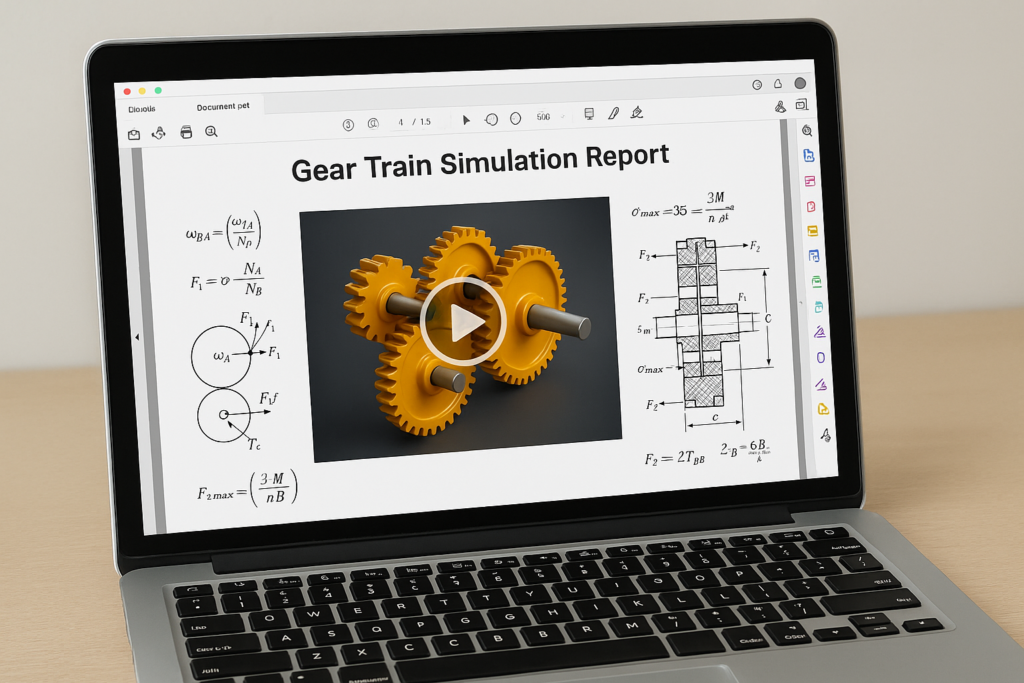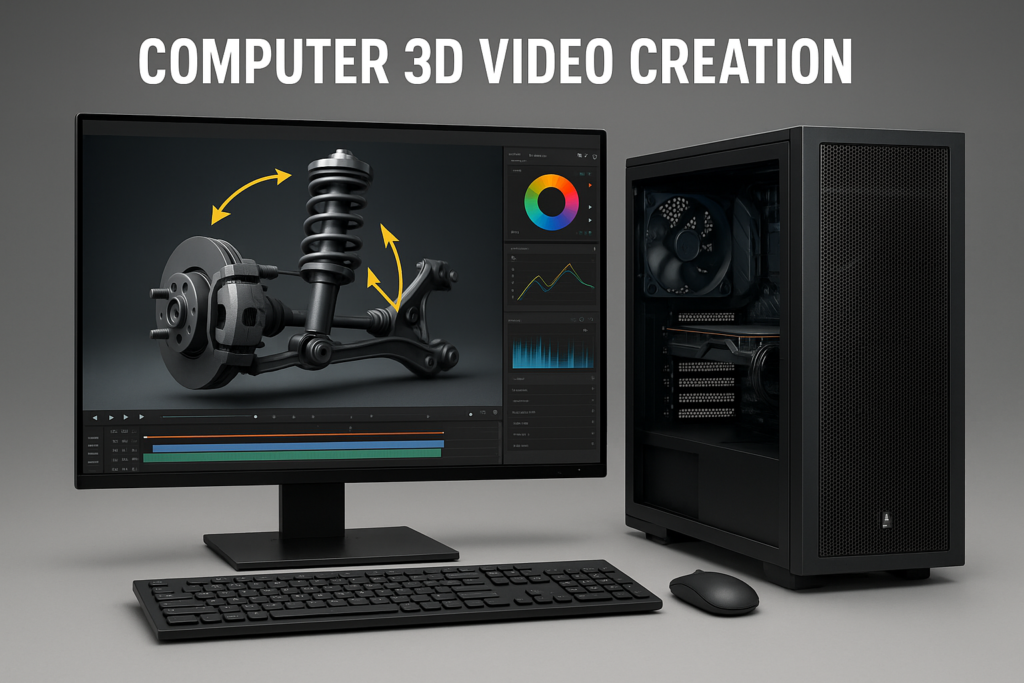
In the modern digital age, mechanical engineering has moved beyond static blueprints and CAD drawings. Today, video content combined with 3D simulations and interactive PDFs provides a powerful way to communicate complex mechanical ideas. Whether you are a student, educator, or design professional, you can make your projects reach thousands more with well-crafted visual storytelling.
This article explores how to create engaging engineering videos, build 3D models in simulation software, and share them through documents like PDFs—making your content both interactive and sharable.

Find best computer for 3d video creation
🌍 3D Simulation Videos: No Language Barrier, High Global Reach, and Big Earnings
3D simulation videos have become a powerful content format that transcends language barriers. Whether you’re explaining how an engine works or visualizing architectural concepts, these videos speak through visuals—making them universally understandable.
💡 Why 3D Simulation Videos Work for Everyone
Unlike traditional videos that rely heavily on voice or subtitles, 3D simulations tell the story visually. Animations, diagrams, and movement naturally guide the viewer’s understanding. This means you can target global audiences without translation—saving time while increasing reach.
💰 High CPC & Monetization
Videos involving engineering, medical procedures, machinery, or software simulations have high Cost-Per-Click (CPC) because advertisers in these niches pay well. If your video explains concepts like “how a four-stroke engine works” or “mechanical stress simulation,” it appeals to high-intent audiences—bringing in premium ads.
| Topic | Estimated CPC (USD) | Language Requirement |
|---|---|---|
| CAD Design Tutorials | $4–$7 | Visual only |
| Medical 3D Simulations | $6–$12 | Minimal |
| Mechanical Engineering | $5–$10 | Visual + Caption |

Find best computer for 3d video creation
🛠️ Created from Your Room
All you need is simulation software like Blender, SolidWorks, or Fusion 360, and screen-recording tools like OBS Studio. You can work right from your room, turning ideas into global educational content.
Example:
Create a 3D animation of a car suspension system in motion. Add dynamic arrows, labels, and exploded views. No voiceover—just clean visuals and background music. Upload it on YouTube with proper tags like “car suspension explained 3D”.
3D simulation content is not only educational and borderless, but it’s also a smart monetization strategy for creators with technical skills.

Find best computer for 3d video creation
🧠 Why Use Videos in Mechanical Engineering?
Traditional technical reports and drawings are vital—but limited in how much they can engage. Engineering videos bring concepts to life through:
- Visualization of real-world motion
- Demonstration of working mechanisms
- Virtual testing and stress simulations
- Layer-by-layer component dissection
These videos are more engaging and educational, making them ideal for social media, YouTube, LinkedIn, and even professional portfolios.
🛠️ Step 1: Create 3D Models in Simulation Software
Start by choosing the right CAD and simulation tool based on your application:
| Software | Use Case | Strengths | Common Output Formats |
|---|---|---|---|
| SolidWorks | Product Design, Static Simulation | Feature-rich, intuitive UI | .SLDPRT, .MP4 |
| ANSYS | Structural, Thermal Analysis | High-accuracy simulation results | .WMV, .AVI |
| Fusion 360 | Collaborative CAD + Simulation | Cloud integration and simulation tools | .MOV, .MP4 |
| Blender | Visualization + Animation | Best for rendering, animation, open-source | .MP4, .FBX |
💡 Pro Tip: Always export a video or animation of the simulation (not just static images). This will form the foundation of your content.
📈 Step 2: Animate the Models for Video Creation
After the 3D model is complete:
- Simulate motion (e.g., a piston moving in SolidWorks Motion Study).
- Add materials and lighting for realism.
- Render animation for export (MP4 or AVI).
For added flair:
- Use camera path animation to zoom into gears, bolts, etc.
- Include label overlays explaining forces, displacements, and constraints.
📩 Step 3: Embed 3D Videos in PDFs (Interactive Reports)
You can make PDFs that contain embedded videos or 3D models—perfect for documentation, presentations, or marketing.
🔧 Tools to Embed 3D in PDFs
| Tool | Purpose | Format Support |
|---|---|---|
| Adobe Acrobat Pro | Embed MP4 or 3D U3D/PRC content | .MP4, .U3D, .PRC |
| SimLab Composer | Export 3D PDF from CAD file | .U3D |
| 3D PDF Maker (ReportGen) | Engineering report generation | .STEP, .IGES to .PDF |
💡 Include video + interactive buttons like:
- “Play Simulation”
- “Exploded View”
- “Stress Map Toggle”

Find best computer for 3d video creation
📢 Step 4: Make Your Video Go Viral in the Engineering Community
Creating the content is only half the battle. Here’s how to maximize reach:
✅ Optimize for YouTube and LinkedIn
| Platform | Format | Tips for Reach |
|---|---|---|
| YouTube | 16:9 landscape | Use titles like “How This Gearbox Works in 3D” |
| 1:1 or 4:5 | Post short clips with technical commentary | |
| Reels (9:16) | Time-lapses or simulations with trending music |
🎯 Use captions, technical hashtags (#MechanicalDesign, #FiniteElementAnalysis) and call-to-action like “Download the 3D PDF here!”
📁 Example Project: Gear Train Simulation
Let’s walk through a common example to tie it all together.
Project: Spur Gear Assembly
| Stage | Tool Used | Action Taken |
|---|---|---|
| Modeling | SolidWorks | Create 3D gears with correct ratio |
| Simulation | SolidWorks Motion | Apply torque, observe speed outputs |
| Rendering | Blender | Apply metal textures and lighting |
| Export | Adobe Acrobat | Embed MP4 + 3D PRC file into PDF |
| Upload | YouTube, LinkedIn | Add thumbnail, title, and description |
👉 Final deliverables:
- 60s simulation video showing torque propagation
- Interactive PDF with video + exploded view
- YouTube and LinkedIn posts with thumbnail and tags
📘 Free Resources for Mechanical Engineers
Here are tools and content you can use to accelerate your video creation journey:
| Resource | Use Case | Link Type |
|---|---|---|
| GrabCAD | Download free CAD models | Website |
| SimScale | Free cloud simulation | Platform |
| Autodesk Education | Free Fusion 360 license | Education Portal |
| Pixabay / Pexels | Royalty-free sound/music | Stock Media |
| OBS Studio | Free screen recording software | Software |
🎓 Use Case: Educational Explainers
Professors and trainers can record screen while:
- Rotating 3D models
- Running simulations
- Explaining load results
Then use video editing tools like:
- Camtasia (Add overlays, arrows, zoom)
- Adobe Premiere Pro (Cut, subtitle, and export)
📌 Add those clips into PDFs or even into course management systems (like Moodle or Google Classroom).

Find best computer for 3d video creation
📤 Bonus: Convert Videos into Shorts & Reels
Re-use your engineering videos across platforms:
| Platform | Max Duration | Format Tips |
|---|---|---|
| YouTube Shorts | 60 sec | Vertical, use captions |
| Instagram Reels | 90 sec | Add sound + gear transitions |
| TikTok | 60-180 sec | Use questions like: “How does this crank work?” |
🎬 Use tools like CapCut or InShot to trim your simulation footage, overlay text like “Stress Point Here 🔴”, and add trending music.
📈 Metrics That Matter
Track your performance to grow your reach:
| Metric | What to Measure | Tool |
|---|---|---|
| Watch Time | Are people watching till the end? | YouTube Analytics |
| Click-through | Are people downloading your PDFs? | Google Drive/Bit.ly stats |
| Engagement | Are users commenting/liking? | LinkedIn, YouTube Studio |
✅ Final Checklist Before Posting
- Export 3D simulation as MP4 or AVI
- Create a 1-minute edit for social media
- Make a high-quality PDF with embedded 3D model or video
- Add CTA (call-to-action) like “Download 3D file” or “Subscribe for more designs”
- Use technical SEO tags and hashtags
📣 Conclusion
Mechanical engineers have a unique advantage in video creation: the subject matter is inherently visual and dynamic. By combining 3D simulation software, video editing, and interactive PDF publishing, you can turn your engineering ideas into viral educational content.
Whether you aim to teach, inspire, or showcase your portfolio—this method bridges technical depth and modern engagement. Get started today by turning your next project into a video and embedding it into a PDF for broader distribution.
Affiliate Disclosure:
This post may contain affiliate links, which means I may earn a small commission if you make a purchase through the links at no extra cost to you. I only recommend products I trust and believe will add value to my readers.